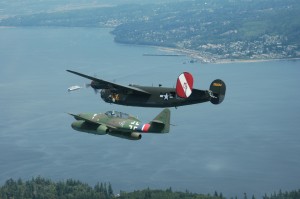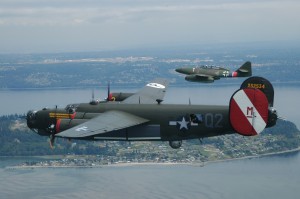
“Project 262, The Test Pilot’s Journal” is Wolf Czaia’s newly published coverage of his Me 262 Project flight experiences at Paine Field. The book includes more than 150 color photos and a DVD of test flight videos narrated by the author.
By Terry Stephens
For the first time in more than 60 years, a Messerschmitt 262 jet fighter flew over Berlin last May, roaring past crowds at the largest International Aerospace Exhibition and Conference ever held. More than 250,000 people attended, with 1,100 exhibitors from 42 countries.
The famous World War II aircraft, the second of five replicas being built by the Legend Flyers’ Me 262 Project at Paine Field (PAE), Everett, Wash., drew attention both in the air and on the ground at the aviation event. The Messerschmitt Foundation, a major supporter of the Me 262 Project, owns and flew the plane.
The Me 262 has been a fascinating topic for global conversations among aviation and history fans in recent years, ever since the first new model of the famous plane flew over Paine Field in 2002—60 years after the original Me 262 flew over Germany. Of the 1,430 planes built during the war, only eight originals remain; seven of them are in museums around the world. Microsoft co-founder Paul Allen owns the only one that is flyable.
Now a colorfully illustrated, highly detailed book has been published, with the inside story of the risks and challenges of building and flying the recreated versions of Germany’s legendary jet fighter. Wolf Czaia, a retired 757 and 767 airline pilot who once flew F-104s with Germany’s Luftwaffe, wrote “Project 262, The Test Pilot’s Journal.” Several years ago, he joined forces with retired Boeing engineering vice president Bob Hammer to test-fly the planes the Me 262 Project are building.
Reproductions of the Me 262s, being built north of Seattle, are accurate in great detail, since production plans were based on a captured German plane used as a template for the project. Unfortunately, the plane had been on duty as a “gate guard” for the past 50 years, at the entrance to Willow Grove Naval Air Station in Pennsylvania.
“It was in a terribly corroded condition,” said Bob Hammer, head of the Legend Flyers group. “Because materials were in short supply during the war, and because the planes weren’t expected to last 50 days, let alone 50 years, it was built with a lot of steel and not much aluminum. Since it was essential to this project, we arranged to borrow it from the Navy, in return for sending them an authentic new static model that has become the new gate guard at the base. But, it’s under cover this time.”

A rare peaceful formation of an Me 262 Stormbird and a B-24 Liberator fly over a Washington ferry and the town of Mukilteo.
Differences in the new Me 262s were made primarily for safety reasons. For instance, the original Junkers Jumo 004B engines, which wore out after about 10 hours of flight, have been replaced with more reliable and long-lasting General Electric J-85s with additional thrust, and the plane’s avionics, behind the authentic wooden instrument panel, have been updated.
Put into service late in WWII, the Me 262 missed its opportunity to change the outcome of that conflict, but its astonishing engineering advancements had a major impact on post-war aircraft design, including America’s swept-wing F-86. The book is fascinating in its technical details for pilots and engineers, but still highly readable for aviation and history enthusiasts.
“It took about six months to write the book,” Czaia said. “Then we worked through thousands of photos to pare them down to around 400, and the publisher chose 150 of the best ones.”
The book includes rare pictures of the first new Me 262 as it escorted a Collings Foundation B-24 Liberator over Czaia’s Whidbey Island home, east of Paine Field.
“That’s the second time a B-24 has flown over my home, but this time it wasn’t dropping bombs,” he said, grinning. “The first time was when a flight of B-24s dropped bombs on my village and destroyed our home in Germany. After that, our family escaped into the Black Forest for safety.”
Rob Collings, flight operations director for the Collings Foundation, who was due to arrive at Paine Field in June as part of a national tour of a B-24 and B-17 bomber, set up the event with the Me 262 Project.
“Rob called to see if I was interested in a photo flight in formation with his B-24,” Czaia said. “It was a rare opportunity to show these two former adversaries flying side by side. One of the most difficult parts of that experience was matching the speeds of the two planes. I slowed to around 180 knots while the bomber flew at its top speed of around 150 knots, so I was constantly changing positions around the plane and circling back for the photo shoot, just to stay in the picture.”
Pacific Northwest aviation photographer Jim Larsen, aboard a French Fouga chase plane flown by Northwest air show performer and former Canadian Snowbirds F-86 pilot Bud Granley, photographed that rare aerial formation, as well as all of the Me 262s test flights. Granley’s son, James, photographed the Stormbird from the bomber’s tail gunner’s position.
The unusual flight inspired Collings, piloting the B-24 that day, to add one of the $2 million copies of the Me 262 to his foundation’s roster of historic combat aircraft. He recently announced an opportunity for private individuals to pilot the legendary jet. After flight training in a dual-control training version of the plane, flights will be set up according to each person’s interests and flying capabilities. Collings is still developing the details of the program, which could possibly include “attacks” on the foundation’s B-17 or B-24 bombers. Tax-deductible donations for that opportunity begin at $25,000.
“The Me 262 embodies all the characteristics expected of an aircraft that changed aerial combat forever,” said Collings. “The mere sight of the Me 262 struck terror in the hearts of all Army Air Corps aircrew who saw it in the sky; it was just so far ahead of its time. Civilian pilots have never before had a chance to fly this legend, and now they do.”

Cruising in formation over Whidbey Island, with Paine Field in the background, this B-24 Liberator and Me 262 Stormbird present an unusual view of these World War II adversaries.
Gordon Page, the Me 262 Project’s sales and marketing representative with AirAssets International, said both the plane and Collings’ opportunity for private flights have attracted interest around the world. Donors are already registering for the 30 hours of instruction that will provide them with a Me 262 type rating on their pilot’s licenses. Because hundreds of people have traveled outside the United States for an opportunity to fly a MiG fighter jet, he believes being able to fly the world’s first jet fighter will draw world attention here.
That same global interest in the Me 262 spurred a German publisher to approach Czaia to write about the unusual projects and his experiences as a test pilot for the historic plane. Many of the Me 262 book’s high-quality color photos come to life in its 45-minute DVD, narrated by Czaia during Me262 test flights and production activity.
“Flying the Me 262 was more of an emotional experience for me than a professional, technical one,” Czaia said. “It’s just an airplane, but it’s emotional when you’re aware of what we’re doing for aviation history with this project. It makes the entire flight completely different, to the point where I couldn’t dwell on it. It would’ve become overwhelming.”
The movie includes a segment where the camera, mounted behind the canopy, captures the plane’s only crash during the test flights.
“Everything was going fine on the second of the flights with the first plane,” Czaia said. “The gear seemed to lower smoothly as I approached the runway, but then the chase pilot told me the nose wheel was only partially extended, and both of the mail wheels were still up. On the next pass, we used an emergency nitrogen bottle to blow down the gear, which gave me three green lights in the cockpit.”
Shortly after landing, Czaia discovered the left main gear was beginning to collapse. He tried to stay on the runway by correcting with aileron control, but the gear kept folding. When the gear gave way completely, the plane’s left engine nacelle dragged along the runway, pulling it to the left and sending the plane down an embankment, where its slow-motion crash ended against a large concrete block that had been dumped on the slope.
“I was just a passenger along for the ride,” said Czaia, who climbed out of the cockpit as rescue crews arrived. “The concrete block caused considerable damage to the wing and right main gear, but if the jet had continued down the ravine, there’s a good chance it would’ve gone on its back.”
Repairing the plane after that crash delayed the project by several months; much of that time was spent trying to track down the cause of the accident. Since the landing gear had been opened and closed 100 times without failure during ground tests, it was a mystery why the gear had failed on landing.

Test pilot Wolf Czaia has flown the first two reproductions of this Me 262. Three more planes are nearly finished at Paine Field.
“We finally discovered that the part that locked the left gear in place had been machined wrong in Texas before we took over the project,” said Hammer. “The difference kept the locking piece of gear mechanism from staying in place to secure the landing gear, but it didn’t show up in the gear tests, only with the weight and force of the landing.”
Today, the Me 262 program has delivered two of the five planes, one to Louis Werner, a retired Arizona judge, and the other to the Messerschmitt Foundation, flown to Germany aboard a Cargolux 747. The third plane is 95 percent complete, the fourth one at 90 percent and the fifth plane at just under 50 percent and waiting for buyers.
Beyond the Me 262 production, Hammer is attracting attention to the Legend Flyers’ expertise in restoring historic aircraft. Already, Bob Hammer LLC and AirAssets International, based in Lafayette, Colo., have signed an agreement to restore to flying condition two Messerschmitt Bf 109s, both F4 models. The work will be done at the Me 262 facilities at Paine Field.
“AirAssets is thrilled to have the opportunity to work with Bob Hammer and his expert team to restore the Bf109s,” said Page, who is president of AirAssets. “Bob and the Me 262 Project team have done a masterful job to put aviation history back in the sky by building five flying Me 262s, and we look forward to the same results on the Bf 109 restorations.”
The company, which markets the Me 262 for Hammer, plans to keep one of the Messerschmitt Bf 109s for display at the new Spirit of Flight Center in Lafayette, Colo. The other plane will be offered for sale.
“They’ve worked closely with our Me 262 team and have seen how committed we are to providing quality workmanship,” Hammer said, noting that both businesses are focused on saving aviation history.
“Project 262, The Test Pilot’s Journal,” a 224-page, large-format book illustrated with 150 color photos, is $98 and signed by the author. Released in Germany in March 2006 and in America last July, it’s available from the publisher at www.twentyninesix.com. Online videos of the plane in flight and details of the Paine Field program are available at [http://www.stormbird.com].











